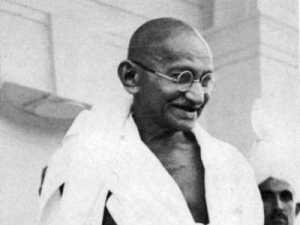Mahatma Gandhi Biography, Biography, Essay (Birth, Death, Murder)

Mahatma Gandhi biography, essay, life introduction mother, wife, son-daughter, killer name, birth-death, list of names of movements, list (Mahatma Gandhi Biography (Jivani) jivan Parichay story itihas history),
Whenever we talk about the history of our country India, there is definitely talk of freedom struggle and discussions are also held on which soldiers who contributed in this freedom struggle. Read about the freedom fighters of India here. There used to be two types of fighters in this freedom struggle,
Before -: Those who wanted to answer the atrocities committed by the British with blood and blood like them, the main ones were -: Chandrashekhar Azad, Sardar Bhagat Singh, etc.
There were other types of fighters -: Those who wanted to get freedom for the country by following the path of peace instead of this bloody scene, the most prominent names among them are -: Mahatma Gandhi. Due to his attitude following peace, truth and non-violence, people started addressing him as ‘Mahatma’. Let us share more information about this Mahatma -:
Table of Contents
Early Life of Mahatma Gandhi [Early Life of Mahatma Gandhi] -:
Mahatma Gandhi’s visit to South Africa [Visit at South Africa] -:
[Return to India and Participation in Freedom Struggle] -:
List of Movements made by Mahatma Gandhi
In the year 1918: Champaran and Kheda Satyagraha -:
In 1919: Khilafat Movement [Khilafat Movement] -:
In 1920 -: Non-cooperation Movement [Non Co-operation Movement] -:
Detailed Description [Description in Detail] -:
Chaura – Chauri incident [Chaura Chauri incident] -:
In 1930: Civil Disobedience Movement / Salt Satyagraha Movement / Dandi March [Civil Disobedience Movement / Salt Satyagrah Movement / Dandi March] -:
Detailed Description [Description in Detail] -:
In 1942: Quit India Movement [Quit India Movement] -:
Detailed Description [Description in Detail] -:
Characteristic of movements [Key features of such movements]-:
Social life of Mahatma Gandhi [Social life of Mahatma Gandhi] -:
[Abolition of Untouchability] -:
Death of Mahatma Gandhi, killer’s name [Death of Mahatma Gandhi] -:
Some other interesting facts about Gandhiji [Some interesting facts about Gandhiji]-:
Title of Father of the Nation [Father of Nation] -:
Mahatma Gandhi Short Biography
Let us share more information about this Mahatma -:
Name Mohandas Karamchand Gandhi
Father’s Name Karamchand Gandhi
Mother’s Name Putlibai
Date of Birth October 2, 1869
Place of birth in Porbandar region of Gujarat
Nationality Indian
education barrister
Wife’s Name Kasturbai Makhanji Kapadia [Kasturba Gandhi]
Children Son Daughter’s name 4 sons – Harilal, Manilal, Ramdas, Devdas
Died 30 January 1948
The killer’s name is Nathuram Godse
Know here 8 women who were close to Mahatma Gandhi
Early Life of Mahatma Gandhi [Early Life of Mahatma Gandhi] -:
Mahatma Gandhi was born in the Porbandar region of Gujarat state of India. His father Shri Karamchand Gandhi was the ‘Diwan’ of Porbandar and mother Putlibai was a religious woman. His mother had a great influence in Gandhiji’s life. He was married at the age of 13 and Kasturba was 14 at that time.
Mahatma Gandhi
In November, 1887, he had passed his matriculation examination and in January, 1888 he joined Samaldas College in Bhavnagar and obtained his degree from here. After this he went to London and from there returned as a barrister.
Mahatma Gandhi’s visit to South Africa [Visit at South Africa] -:
In 1894, in connection with a legal dispute, Gandhi went to South Africa and launched a ‘Disobedience Movement’ against the injustice done there and returned to India after its completion.
Know the history of Sabarmati Ashram built by Mahatma Gandhi
[Return to India and Participation in Freedom Struggle] -:
In 1916, Gandhiji returned to India from South Africa and then started taking his steps for the independence of our country. After the death of Congress leader Bal Gangadhar Tilak in 1920, Gandhiji was the guide of the Congress.
In the First World War [1st World War] that took place between 1914 – 1919, Gandhiji gave full cooperation to the British government on the condition that after that they would liberate India. But when the British did not do this, then Gandhiji started many movements to get independence for the country. Some of these movements are as follows -:
In 1920 -: Non-Cooperation Movement [Non Co-operation Movement],
In 1930 -: Disobedience Movement [Civil Disobedience Movement],
Quit India Movement [Quit India Movement] in 1942.
By the way, the whole life of Gandhiji was like a movement. But mainly 5 movements were run by him, out of which 3 movements were run all over the nation and were very successful and hence people also know about them. We can categorize all these movements run by Gandhiji as follows:
List of Movements made by Mahatma Gandhi
Major Movement Other Movement / Early Stage Movement
In 1920 -: Non-Cooperation Movement [Non Co-operation Movement],
In 1930 -: Disobedience Movement / Salt Satyagraha Movement / Dandi March [Civil Disobedience Movement / Salt Satyagrah Movement / Dandi March],
In 1942 – Quit India Movement [Quit India Movement].
In the year 1918 -: Champaran and Kheda Satyagraha,
In 1919 -: Khilafat Movement [Khilafat Movement].
How did Mahatma Gandhi get India’s independence on 15th August
Year wise description of all these movements is being given as follows:
In the year 1918: Champaran and Kheda Satyagraha -:
The ‘Champaran and Kheda Satyagraha’ launched by Gandhiji in 1918 was the beginning of his movements in India and he was successful in this. This Satyagraha was launched against the British Landlord. Indian farmers were being forced by these British landlords to produce indigo and at the same time, to the extent that they were being forced to sell this indigo at a fixed price and the Indian farmers Didn’t want that. Then he took the help of Mahatma Gandhi. On this Gandhiji launched a non-violent movement and was successful in this and the British had to obey him.
In the same year, a village named Kheda, which is located in the Gujarat province, was flooded and the farmers there were unable to pay the tax levied by the British government. Then he took help from Gandhiji for this and then Gandhiji used a weapon called ‘Non-cooperation’ and agitated for the farmers to get tax exemption. Gandhiji got a lot of support from the public in this movement and finally in May, 1918, the British government had to announce relief to the farmers in its tax rules.
In 1919: Khilafat Movement [Khilafat Movement] -:
In 1919, Gandhiji was beginning to realize that the Congress was weakening somewhere, so he made his efforts to save the sinking ship of the Congress as well as to oust the British Government through Hindu-Muslim unity. Started. For the fulfillment of these objectives, he went to the Muslim society. The Khilafat movement was a global movement, which was run against the Caliph of Muslims. Mahatma Gandhi held a conference of Muslims of the entire nation [All India Muslim Conference] and he himself was also the main person of this conference. This movement supported the Muslims a lot and this effort of Gandhiji made him a national leader [National Leader] and he also got a special place in the Congress. But in the year 1922, the Khilafat movement stopped badly and after that Gandhiji continued to fight for ‘Hindu Muslim unity’ all his life, but the distance between Hindus and Muslims kept increasing. read nore
India’s first freedom struggle of 1857, read here
In 1920 -: Non-cooperation Movement [Non Co-operation Movement] -:
To deal with various movements, the British government passed the Rowlett Act in 1919. During this time some meetings were also organized by Gandhiji and like those meetings, meetings were also organized at other places. A similar meeting was convened at Jallianwala Bagh in the Amritsar region of Punjab and Gandhi started the Non-Cooperation Movement in 1920 in protest against the brutality with which the British had trampled on this peace meeting. The meaning of this non-cooperation movement was that the British government should not be helped in any way by the Indians. But there should be no violence in it.
Go to home page

0 comments